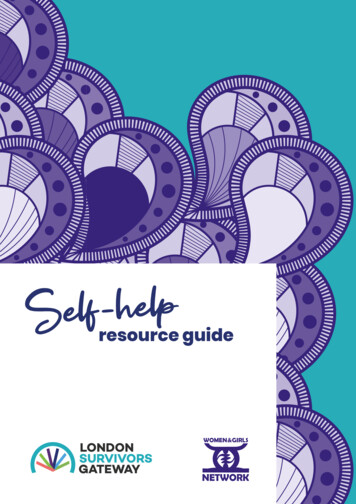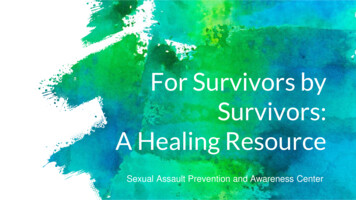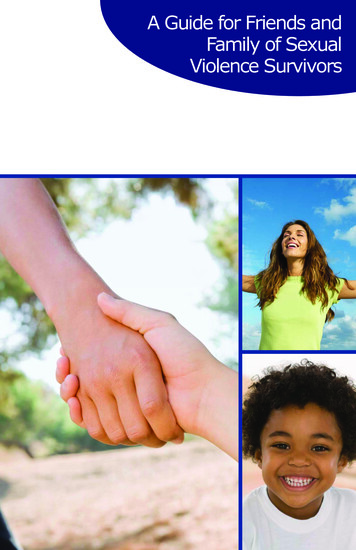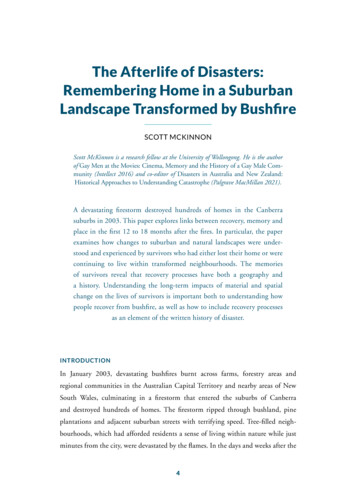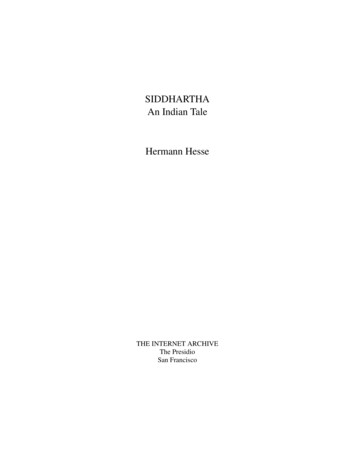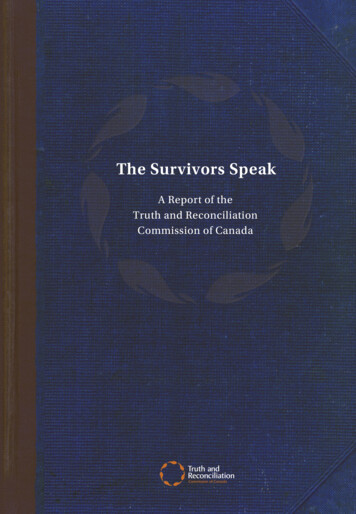
Transcription
The Survivors SpeakA Report of theTruth and ReconciliationCommission of Canada
The Survivors SpeakThe Truth and ReconciliationCommission of Canada
This report is in the public domain.Anyone may, without charge or request for permission, reproduce all or part of this report.2015Truth and Reconciliation Commission of CanadaWebsite: www.trc.caLibrary and Archives Canada Cataloguing in PublicationTruth and Reconciliation Commission of CanadaThe survivors speak : a report of the Truth and Reconciliation Commission of Canada.Issued also in French under title: Les survivants s’expriment, un rapport de la Commission de vérité et réconciliation au Canada.Available also on the Internet.Includes bibliographical references.ISBN 978-0-660-01985-7Cat. no.: IR4-5/2015E1. Native peoples--Canada--Residential schools. 2. Native peoples—Canada--History.3. Native peoples--Canada--Social conditions. 4. Native peoples—Canada--Government relations.5. Truth and Reconciliation Commission of Canada. 6. Truth commissions--Canada.I. Title. II. Title: Report of the Truth and Reconciliation Commission of Canada.E96.5 T78 2015971.004’97C2015-980020-X
ContentsPreface.vIntroduction.1Life before residential school.3Forced departure.13A place of refuge.19The journey.23Arrival.31Language and culture.47Bedwetting.59Daily life.63Strange food.69School meals.71Chores.79Religious training.85Separating siblings.91Gender relations.95Contact with parents.99Fear, loneliness, and emotional neglect.109Despair .117Hiding the truth.119Classroom experience.121Regimentation.129Integration into public schools.131Truancy.133Discipline.139
Abuse .153Student victimization of students .165Medical attention.177Disability .183Warm memories .185Sports and recreation .189Cadets .197Improvements .199The end .201Bibliography .205Endnotes .209
PrefaceOn June 11, 2008, Prime Minister Stephen Harper issued an apology to the for-mer students of Canada’s Indian residential school system, calling it a “sadchapter in our history.” That chapter is part of a broader story: one in whichthe Canadian government gained control over Aboriginal land and peoples, disruptedAboriginal governments and economies, and sought to repress Aboriginal cultures andspiritual practices. The government, often in partnership with the country’s major religious bodies, sought to ‘civilize’ and Christianize, and, ultimately, assimilate Aboriginalpeople into Canadian society. The deputy minister of Indian Affairs predicted in 1920 thatin a century, thanks to the work of these schools, Aboriginal people would cease to exist asan identifiable cultural group in Canada.Residential schools were seen as a central element in this project. For their part, Aboriginalpeople saw the value in schooling. It wasat their insistence, for example, that manyTreaties required government to provideteachers and establish reserve schools.The decision to invest in residential schoolswas based on a belief that the cultural andspiritual transformation that the government and churches sought to bring aboutin Aboriginal people could be most effectively accomplished in institutions thatbroke the bonds between parent and child.Ojibway woman with child in carrier basket. 1858. Libraryand Archives Canada/Credit: Humphrey Lloyd Hime/NationalArchives of Canada fonds/C-000728.
vi Truth & Reconciliation CommissionThe Roman Catholic mission and residential school in Beauval, Saskatchewan. Deschâtelets Archives.When Canada was created in 1867, the churches were already operating a small number of boarding schools for Aboriginal people. In the coming years, Roman Catholic andProtestant missionaries established missions and small boarding schools throughout theWest. The relationship between the government and the churches was formalized in 1883when the federal government decided to establish three large residential schools in western Canada.According to the Indian Affairs annual report for 1930, there were eighty residential schoolsin operation across the country.1 The Indian Residential Schools Settlement Agreement of2006 provided compensation to students who attended 139 residential schools and residences.2 The federal government has estimated that at least 150,000 First Nation, Métis,and Inuit students passed through these schools.3The assault on Aboriginal identity usually began the moment the child took the first stepacross the school’s threshold. Braided hair (which often had spiritual significance) was cut,homemade traditional clothing was exchanged for a school uniform, Aboriginal nameswere replaced with Euro-Canadian ones (and a number), and the freedom of life in theirown communities was foregone for the regimen of an institution in which every activity
Preface viiStudents at the Roman Catholic school in Fort George, Québec, 1939. Deschâtelets Archives.from morning to night was scheduled. Males and females, and siblings, were separated,and, with some exceptions, parental visits were discouraged and controlled.Hastily and cheaply built schools often had poor or non-existent sanitation and ventilation systems. With few infirmaries in which students with contagious diseases could beisolated, epidemics could quickly spread through a school with deadly results. Becauseschools were funded on a per capita basis, administrators often violated health guidelines and admitted children who were infected with such deadly and contagious diseasesas tuberculosis. Often, parents were not informed if their children became sick, died, orran away.For the first half of the twentieth century, the schools were on what was termed the “halfday system,” under which half a day was spent in the classroom and the other half in vocational training. For the boys, this was largely restricted to farming and the crafts that afarmer might have need of, while the girls were trained in the domestic sciences. In reality,this was not so much training as child labour, undertaken to subsidize the ongoing operation of the schools.
viii Truth & Reconciliation CommissionBoys cutting wood at the Fort Resolution, Northwest Territories, school. Canada, Department of Interior, Library and ArchivesCanada, PA-048021.The government mandated that English (or in Québec, French) be the language of instruction. And, although some missionaries had learned Aboriginal languages and providedreligious instruction in those languages, in many schools, students were punished forspeaking their language.For most of the system’s history, the federal government had no clear policy on discipline.Students were not only strapped and humiliated, but in some schools, they were alsohandcuffed, manacled, beaten, locked in cellars and other makeshift jails, or displayed instocks. Overcrowding and a high student–staff ratio meant that even those children whowere not subject to physical discipline grew up in an atmosphere of neglect.From the beginning, many Aboriginal people were resistant to the residential school system. Missionaries found it difficult to convince parents to send their children to residentialschools, and children ran away, often at great personal risk and with tragic outcome.
Preface ixStudents and staff working in the kitchen in the Edmonton, Alberta, school. The United Church of Canada Archives, 93.049P885N.Although the issue of sexual abuse was largely unreported during the years in which theschools were in operation, over the past twenty-five years, it has become clear that this wasa serious problem in some schools.For most of the history of residential schools, teachers’ wages in those schools were farbelow those offered to other teachers, making the recruitment and retention of teachersan ongoing issue. Although many remarkable people devoted their lives to these institutions, the churches did not require the same level of teacher training as was expected bythe Canadian public school system.Many students have positive memories of their experiences of residential schools andacknowledge the skills they acquired, the beneficial impacts of the recreational and sporting activities in which they engaged, and the friendships they made. Some students wentto public schools so they could graduate and attend post-secondary institutions anddevelop distinguished careers. But, for most students, academic success was elusive and
x Truth & Reconciliation CommissionOne of the most northerly schools was at Coppermine in the Northwest Territories. General Synod Archives, Anglican Church ofCanada P2004-09-404.they left as soon as they could. On return to their home communities, they often felt isolated from their families and their culture. They had lost their language and had not beenprovided with the skills to follow traditional economic pursuits, or with the skills neededto succeed in the Euro-Canadian economy. Worst of all, they did not have any experienceof family life or parenting.By the 1940s, federal officials concluded that the system was both expensive and ineffective. As a result, the federal government began to substantially increase the number ofon-reserve day schools and, in the 1950s, to enter into agreements with provincial governments and local school boards to have Aboriginal students educated in public schools.This policy of slowly winding down the residential school system was coupled with anexpansion of the system in the Canadian North from 1955 onwards. Once again, childrenwere separated from families for lengthy periods, taught by people who had no understanding of their language or culture, and housed in crowded and makeshift facilities.
Preface xiWilliams Lake, British Columbia, school hockey team. Museum of the Cariboo Chilcotin.The partnership with the churches remained in place until 1969 and, although most of theschools had closed by the 1980s, the last federally supported residential schools remainedin operation until the late 1990s.In the 1980s, various members of Canadian society began to undertake a reassessmentof the residential school experience. Starting in 1986, Canadian churches began to issueapologies for attempting to impose European culture and values on Aboriginal people.Apologies specific to the residential schools were to follow in the 1990s. Former studentsbegan to speak out publicly about their experiences, leading to both criminal chargesagainst some sexual abusers and the launching of class-action lawsuits against the churchesand the federal government. The cases were eventually resolved in the Indian ResidentialSchools Settlement Agreement, the largest class-action settlement in Canadian history,which was reached in 2006 and came into effect in 2007.That agreement provided for a payment to all former students who resided in federallysupported residential schools, additional compensation for those who suffered serious personal harm, a contribution to the Aboriginal Healing Foundation, support for
xii Truth & Reconciliation Commissioncommemoration projects, the establishment of the Truth and Reconciliation Commissionof Canada, and the provision of mental-health supports for all participants in SettlementAgreement initiatives.As part of its work, the Truth and Reconciliation Commission of Canada provided formerstudents—the Survivors of residential schools—with an opportunity to provide a statement on their experience of residential schooling. This volume of excerpts from thosestatements is being published as a part of the Commission’s final report.At the beginning of the Commission’s work, we questioned the use of the word “Survivor.”It seemed to be a limiting, almost pejorative word. We saw it as referring to someone whowas “just getting by,” or “beaten down.” We endeavoured to find an alternative, more suitable, word to ascribe to those who came out of the Indian residential schools.However, over time, we have developed a whole new respect for the word. In “Invictus”(the title means “invincible” or “undefeated” in Latin), the English poet William ErnestHenley (1849–1903) wrote these words:Out of the night that covers me,Black as the pit from pole to pole,I thank whatever gods may beFor my unconquerable soul.In the fell clutch of circumstanceI have not winced nor cried aloud.Under the bludgeonings of chanceMy head is bloody, but unbowed.Beyond this place of wrath and tearsLooms but the Horror of the shade,And yet the menace of the yearsFinds and shall find me unafraid.It matters not how strait the gate,How charged with punishments the scroll,I am the master of my fate,I am the captain of my soul.
Preface xiiiA Survivor is not just someone who “made it through” the schools, or “got by” or was “making do.” A Survivor is a person who persevered against and overcame adversity. The wordcame to mean someone who emerged victorious, though not unscathed, whose head was“bloody but unbowed.” It referred to someone who had taken all that could be thrown atthem and remained standing at the end. It came to mean someone who could legitimatelysay “I am still here!” For that achievement, Survivors deserve our highest respect. But, forthat achievement, we also owe them the debt of doing the right thing. Reconciliation is theright thing to do, coming out of this history.In this volume, Survivors speak of their pain, loneliness, and suffering, and of their accomplishments. While this is a difficult story, it is also a story of courage and endurance. Thefirst step in any process of national reconciliation requires us all to attend to these voices,which have been silenced for far too long. We encourage all Canadians to do so.Justice Murray SinclairChair, Truth and Reconciliation Commission of CanadaChief Wilton LittlechildCommissionerDr. Marie WilsonCommissioner
IntroductionBefore the Survivor-initiated court case that led to the creation of the Truth andReconciliation Commission of Canada, the Canadian residential school story haslargely been told, to the extent that it has been told at all, through the documentsand reports of the people who organized and ran the system. These documents describethe goals and methods of the federal government that founded and funded the schools,and of the religious organizations that operated them. Their written records contain therationales for continued residential school operation, as well as internal, and occasionallypublic, criticisms of the schools. These have provided the basis for valuable histories.Over the past thirty years, a growing number of former students have published theirmemoirs. In addition, Aboriginal organizations and individual academics have conductedresearch, and, in some cases, compiled and published transcripts of interviews and writings by former students, often with a focus on a specific school.The Truth and Reconciliation Commission of Canada was mandated “to receive statements and documents from former students, their families, community and all otherinterested participants” and to recognize “the unique experiences” of all former students.Over 6,750 people have given recorded statements to the Truth and ReconciliationCommission of Canada. Most of these were given in private settings. Others were givenat the national, regional, and community events; sharing circles; and hearings organized by the Commission. These private and public statements form a key part of theCommission’s legacy.The Commission recognizes that the essential voice of the former students must begiven a central place in any history of the schools. Since statement gathering has beenan ongoing process throughout the Commission’s mandate, it has not been possible toundertake a complete assessment and analysis of all the statements. This volume is basedon a survey of the statements gathered from all parts of the country between 2009 and2014. Almost all the statements come from individuals who attended schools after 1940.The volume begins with the students’ lives prior to attending residential school, and thendescribes their arrival at the schools, and their experiences studying, working, and livingin the schools.Commentary and interpretation have been kept to a minimum to allow the students tospeak for themselves.
Life before residential school“We were loved by our parents.”When I think back to my childhood, it brings back memories, really nice memories ofhow life was as Anishinaabe, as you know, how we, how we lived before, before wewere sent to school. And the things that I remember, the legends at night that my dadused to tell us, stories, and how he used to show us how to trap and funny things thathappened. You know there’s a lot of things that are really, that are still in my thoughtsof how we were loved by our parents. They really cared for us. And it was such a goodlife, you know. It, it’s doing the things, like, it wasfree, we were free I guess is the word I’m lookingfor, is a real free environment of us. I’m not sayingthat we didn’t get disciplined if we got, if we didsomething wrong, we, you know. There was that,but not, but it was a friendly, friendly, like a lovingdiscipline, if you will.— Bob Baxter, Statement to the Truth andReconciliation Commission of Canada,Thunder Bay, Ontario, 24 November 2010.1Bob Baxter.I’m come from a long way, I came a long way. I’mfrom Great Lake Mistissini. That’s where I was bornin the bush. It was a pride for me to say that because I was born in the bush in a tent.It’s something that remains in my heart going to the woods, living in the woods. It’sin my heart. Before going to the boarding school, my parents often told me what theywere doing in the woods when I was born. What they were doing, we were in campwith other families. The stories my father told us, my mother, too.— Louise Bossum, Statement to the Truth and Reconciliation Commissionof Canada, La Tuque, Québec, 6 March 2013.2Many former students spoke of what their lives were like prior to going to residentialschool. These recollections describe the ways in which cultural and spiritual practices andvalues had been transmitted from one generation to the next before life in the schoolsinterfered with that process. They are also a reminder that these practices—and the languages in which they were embedded—are not things of the ancient past, but, rather, arevibrant elements of the childhoods of people who are still alive. Whether the governmental
4 Truth & Reconciliation Commissiongoal was assimilation, as initially stated, or, as the government later claimed, integration,the cultural practices described in the following section were under attack.Before she was enrolled in residential school in Québec in the 1960s, Thérese Niquaylived on what she described as “the family territory.” She had very positive memories ofthat part of her life.I remember especially the winter landscapes, fall landscapes too. I remember verywell I often looked at my father, hunting beaver especially. I admired my father a lot.And I remember at one point I was looking at him, I think I was on the small hill, andhe was below, he had made a hole in the ice, and he was hunting beaver with a, witha harpoon, and I was there, I was looking at him and I was singing. And I rememberwhen I was kid I sang a lot, very often. And I also remember that we lived or my, mypaternal grandmother was most often with us, my, my father’s mother, and we livedin a large family also, an extended family in the bush. Those are great memories.3Jeannette Coo Coo, who attended the La Tuque, Québec, school in the 1960s, said shewas a member of what might be the last generation of Aboriginal people who were raisedin the forest.In the forest, what I remember of my childhood was bearskin, which I liked. I wasthere, and it was the bearskin that my father put for us to sit on, that was it. That iswhy I’m pleased to see that here. And what I remember in my childhood also wasthe, my mother’s songs, because we lived in tents, and there was young children, andmy mother sang for the youngest, and at the same time this helped us to fall asleep.It was beneficial to everyone, my mother’s songs, and that is what I remember, thatis what I am happy to say that it was what was, I was raised with what was instilled inme, so to speak.4Albert Elias grew up in the Northwest Territories near the community of Tuktoyaktuk.Yeah, when I first opened, like, when I first saw the world, I guess, we were outdoorsand when I opened my eyes and started to, you know, and I was just a baby, I guess,and I, we were out in the land. The land was all around me, the snow, the sky, thesun, and I had my parents. And we had a dog team. We were travelling, I think it wason Banks Island, and I was amazed at what I saw, just the environment, the peace,the strength, the love, the smile on my dad’s face. And when I wake up he’s singing ashort song to me of love.5In the 1940s, Paul Stanley grew up speaking Kootenai (Ktunaxa) in the interior of BritishColumbia. As he told the Commission, he learned the language from his father. “Whenyou’re in bed with Papa, and he tells you about your first story, and it’s about how thechipmunk got his stripes, and it was so funny to me, you know that I asked him every nightto say it again.”6Eva Lapage was born in Ivujivik, in northern Québec, in 1951.
Life before residential school 5When I was a little girl, ’cause we live in igloo and we live in nomadic life and therewas no white people and we move around from camp to camp, depending on theseason. And we live with nature and our family andeverybody looks after each other. And it was very,very simple, living, just survival in the way, lookingfor food and moving around.7Bob Baxter was born on the Albany River in northern Ontario.So, that’s how I, that’s how I grew up, you know, andknowing all that stuff where listening to the familiarsounds of my dad’s snowshoes in the winter whenhe came to, when he came back from trapping latein the afternoon, towards, when it’s already dark,and waiting for him to come home and tell us thelegends, because no tv back then.Eva Lapage.So, it was great. My mom was great, too. She really looked after us, made sure that wewere clothed and fed. That was good times.I remember eating wild game all the time. And ’cause we had our grandparents thatreally looked after us, too, that I have good memories of, until, ’til that day that wewere taken from there, taken away to school.8Prior to attending the Roman Catholic school in Kenora, Ontario, Lynda PahpasayMcDonald lived with her family near Sydney Lake in northwestern Ontario in the 1950s.We spent most of our time in the trapline, in thecabin, and we’d play outside and it was really good.There was no drinking. There was, it was, like, itwas a small sized cabin, and my parents took goodcare of us. And they were really, I remember thosehappy days, like there was no violence. We had alittle bit of food, but we always had a meal, like weate, the beaver meat or moose meat if my dad got amoose, and deer meat, and, and fish.She could not recall being physically disciplinedduring this time. “They more or less just told me, youknow, don’t do this, you know you’ll hurt yourself Lynda Pahpasay McDonald.and what not, but it was all in Ojibway, all spoken inOjibway. And I spoke Ojibway when I was a child, and there was a lot of fun.” Her motherwould harvest plants to be used as medicine.And we would, my parents would take us out blueberry picking, and my grandparents would always take us blueberry picking, or we’d go in the canoe, and we’d go,
6 Truth & Reconciliation Commissionyou know, or my grandmother would always be gathering traditional medicines. Shehad picked the wild ginger, and I would go with her, and we’d go pick all the medicines that we needed.And I also remember my mom picking up this medicine. It would, like, if we had anycut, or open wound, she would use this, like a ball, like, sort of a fungus ball, and shewould open it, and she would put it on our wounds and whatever, and would heal,you know, real fast. And, and she knew all her traditional medicines.And at the time, I remember my, my grandpa and my dad, they used to have a drum,and they would, you know, drum and they would sing, during certain time of theyear.9Mabel Brown had similar memories of her life growing up in the Northwest Territories.You know life in the bush is really good. And when, when we were growing up wewent, when my dad was alive, him and my mom brought us out into the bush. Andwe, we went as a family together. They taught us, when they’d teach us they taughtus how to do things. They’d tell us first, they’d show us, and then we’d do it and thenthat’s how we learned that. And that’s how so many people now know when, whenwe see a snare or how to set it or set traps because my grandmother showed me howto set traps.And how to tell what kind of trees are what and what the different kind of things youtake off the gum, and things like that; what it’s used for and you know, chew and mymom and dad used to dig up roots from the ground and I used to just love that roots.Chew on it and all those things are medicine for our bodies too. And I still, I still, can’teat just store-bought foods. I have to have caribou or fish or moose meat or something like that and to, to feel full; to feel satisfied.10Emily Kematch was born in 1953 in York Factory, Manitoba, and grew up in York Landing.My family is Cree in origin. My mom and dad spoke Cree and that’s my Native language is Cree and that’s the only language I spoke at home. And when I was six yearsold, I only understood basic, really like from my brothers and sisters when they cameback from residential school. Like, “What is your name?” And I knew to say, “Emily”and not very much English. And I was very close to my mother. Her and I were, I wasjust attached to her like, I loved my mother and I knew she loved me. Same with myfather, he showed it in different ways.He was a very quiet man, but his actions spoke volumes. He hunted, he was a hunter,a trapper, a fisherman and that’s how we survived, my family because he didn’t work,he didn’t have a job and my father was a, what they call a lay reader in the Anglicanfaith. He led church services in my community and my family was Anglican in faith.My father ran the services in my hometown of York Landing. He did the services inCree and that’s what I miss about our community right now, is that aspect is the Creesinging, ’cause it’s not around anymore.11
Life before residential school 7Piita Irniq was born near Repulse Bay, in what is now Nunavut.I lived in an igloo in the wintertime. A very happyupbringing with my family, and both my motherand father were very good storytellers, and theywould tell legends, and they would sing songs,traditional, sing traditional Inuit songs. They would,my father in particular, would talk about hunting stories.My mother would sew all of the clothes that we had,you know, caribou clothing and things like that,sealskin clothing. I still wear sealskin clothing toda
The survivors speak : a report of the Truth and Reconciliation Commission of Canada. Issued also in French under title: Les survivants s’expriment, un rapport de la Commission de vérité et réconci-liation au Canada. Available also on the Internet. Includes bibliographical re

